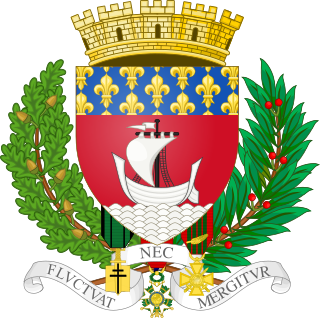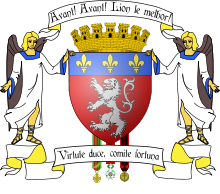
Heraldry is a discipline relating to the design, display and study of armorial bearings, as well as related disciplines, such as vexillology, together with the study of ceremony, rank and pedigree. Armory, the best-known branch of heraldry, concerns the design and transmission of the heraldic achievement. The achievement, or armorial bearings usually includes a coat of arms on a shield, helmet and crest, together with any accompanying devices, such as supporters, badges, heraldic banners and mottoes.

The fleur-de-lis, also spelled fleur-de-lys, is a common heraldic charge in the shape of a Iris pseudacorus. Most notably, the fleur-de-lis is depicted on the traditional coat of arms of France that was used from the High Middle Ages until the French Revolution in 1792, and then again in brief periods in the 19th century. This design still represents France and the House of Bourbon in the form of marshalling in the arms of Spain, Quebec and Canada, for example.

The coat of arms of Canada, also known as the Royal Coat of Arms of Canada or, formally, as the Arms of His Majesty The King in Right of Canada, is the arms of dominion of the Canadian monarch and, thus, also the official coat of arms of Canada. In use since 1921, it is closely modelled after the royal coat of arms of the United Kingdom, with French and distinctive Canadian elements replacing or added to those derived from the British version.

The original coat of arms of New Brunswick was granted to New Brunswick by a Royal Warrant of Queen Victoria on 26 May 1868. The provincial flag is a banner of the arms.

The coat of arms of Nova Scotia is the heraldic symbol representing the Canadian province of Nova Scotia. It is the oldest provincial achievement of arms in Canada, and the oldest British coat of arms in use outside Great Britain. It is blazoned as follows: Argent, a saltire azure charged with an escutcheon of the Royal Arms of Scotland.

The coat of arms of Quebec was adopted by order-in-council of the Government of Quebec on 9 December 1939, replacing the arms assigned by royal warrant of Queen Victoria on 26 May 1868.

In British heraldry, a coronet is any crown whose bearer is less than sovereign or royal in rank, irrespective of the crown's appearance. In other languages, this distinction is not made, and usually the same word for crown is used irrespective of rank In this use, the English coronet is a purely technical term for all heraldic images of crowns not used by a sovereign, and implies nothing about the actual shape of the crown depicted. A Coronet is another type of crown, but is reserved for the lower ranks of nobility like Marquesses and Marchionesses, Earls and Countesses, Barons and Baronesses, and some Lords and Ladies. The specific design and attributes of the crown or coronet signifies the hierarchy and ranking of its owner.

The coat of arms of France is an unofficial emblem of the French Republic. It depicts a lictor's fasces upon branches of laurel and oak, as well as a ribbon bearing the national motto of Liberté, égalité, fraternité. The full achievement includes the star and grand collar of the Legion of Honour. This composition was created in 1905 by heraldic painter-engraver Maurice de Meyère, and it has been used at the Foreign Ministry during state visits and for presidential inaugurations.

The first coat of arms of Montreal was designed by Jacques Viger, the first mayor of Montreal, and adopted in 1833 by the city councillors. Modifications were made some one hundred five years later and adopted on 21 March 1938, and again on 13 September 2017, resulting in the version currently in use. The coat of arms was the only city emblem representing Montreal until 1981, when a stylized logo was developed for common daily use, reserving the coat of arms for ceremonial occasions.

The coat of arms of Scotland, colloquially called the Lion Rampant, is the coat of arms historically used as arms of dominion by the monarchs of the Kingdom of Scotland, and later used within the coat of arms of Great Britain and the present coat of arms of the United Kingdom. The arms consist of a red lion surrounded by a red double border decorated with fleurs-de-lis, all on a gold background. The blazon, or heraldic description, is: Or a lion rampant Gules armed and langued Azure within a double tressure flory-counter-flory of the second.

The coat of arms of the Cape Colony was the official heraldic symbol of the Cape Colony as a British colony from 1875 to 1910, and as a province of South Africa from 1910 to 1994.
The people and province of Quebec have created and established several symbols throughout Quebec's history to represent the collective identity of its residents. Many of Quebec's symbols are related to its history, to catholicism, to Quebec's winters and/or the fauna and flora of Quebec. The motif most commonly seen in Quebec's various symbols is the fleur de lys, which is associated with the French language and New France.

The flag and coat of arms of Normandy are symbols of Normandy, a region in north-western France.

The coat of arms of Paris, or simply the Blazon of Paris, shows a silver sailing ship on waves of the sea in a red field, with a chief showing the Royal emblem of gold-on-blue fleur-de-lis. Originally introduced in the 14th century, its current form dates to 1853. The city motto is Fluctuat nec mergitur. The traditional colors of the city of Paris are red and blue.

French heraldry is the use of heraldic symbols in France. Although it had a considerable history, existing from the 12th century, such formality has largely died out in France, as far as regulated personal heraldry is concerned. Civic heraldry on the other hand remains a visible part of daily life.

The coat of arms of Marseille has witnessed its existence since the 14th century. The current version was adopted in 1883.

The flag of Lyon consists of a rectangular cloth on which the elements of its coat of arms are displayed, it is therefore a heraldic flag. Habitually it counts on habitual proportions of 3:2 and it is a flag for civil use, since in the City hall and its dependencies only the French national flag is raised.
This page shows the coats of arms, heraldic achievements, and heraldic flags of the House of Nassau.

The coat of arms of McGill University is the official emblem of the university and derives from a heraldic device assumed during the lifetime of the university's founder, James McGill. The first iteration was designed in 1906 by Percy Nobbs, then director of the McGill School of Architecture. The design subsequently varied for decades after until the university's current coat of arms, largely resembling the original design, was finally adopted by the Board of Governors in 1975. Today, the university has approved multiple logos across its faculties and departments, including a separate coat of arms used by the Macdonald Campus.


























